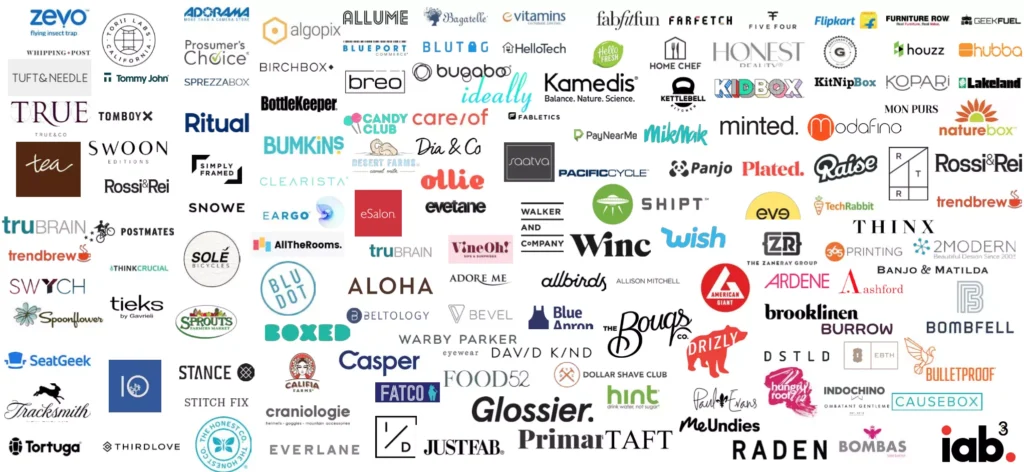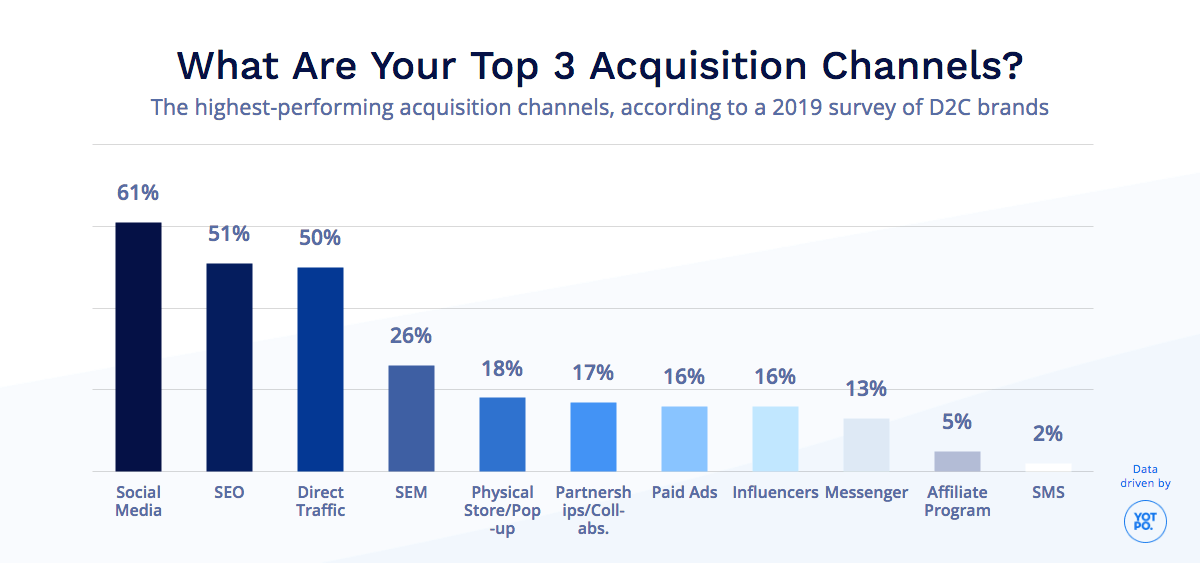Back in the days of yore (like, 2007), discovering a new brand had everything to do with where it was placed on store shelves. Brands paid a high price to be placed at the eye level of their primary audience: parents scoping the aisles for a new health food, kids looking for cookies or sugary cereal to beg mom and dad to buy for them, bored folks in the checkout line.
In a brick-and-mortar setting, the really good stuff is always proudly displayed on end caps. Whether it’s a department store encouraging their shoppers to try a new fashion brand, a grocer displaying a new food item, or a fancy display at an electronics retailer flaunting their Apple offerings, product discovery is all about physical store layout—unless you’re selling online.
The shelfless direct-to-consumer (DTC) ecommerce world has turned how consumers discover brands to like, love, and stay loyal to on its head.
Today, product discovery is much more complicated than just dishing out the big bucks for a spot on an end cap. After all, everything’s at eye-level when people are shopping on a phone. Across a litany of digital channels, fresh brands we aren’t familiar with pop up all the time—consider that 78% of Amazon searches are unbranded.
Even when people shop on retailer websites, they come across brands they’re not going to be familiar with—it’s much more likely that shoppers search for “coffee” than for “Folgers.” This enables consumers to discover new brands every time they shop. All of this means that as ecommerce continues to grow and match brick-and-mortar shopping, there’s an opportunity for any brand, big or small, to be discovered by consumers.
Modern shoppers aren’t loyal to brands simply because it’s what was used in their home growing up, and they aren’t as instantly swayed by slashed prices as previous generations were. Instead, the opportunities to discover a new brand and product have been ripped wide open. All that’s left is for DTC merchants to uncover the ways shoppers discover new favorites.
The Uprising of DTC Brands and Ecommerce
Direct-to-consumer brands are, more often than not, digitally native brands. This means the brand was launched online and focuses on manufacturing their products and selling them right to the consumer instead of going through a retailer or marketplace.

Digitally native strategies are sparked and developed through an online-first lens instead of an in-person shopping lens. In lieu of planning the ambient music or store blueprint, DTC brands consider the online customer experience first and thread it throughout their business—even if they develop into a physical location, like Warby Parker. This is different from many well-known, established brands that found ecommerce later in life, like Nike or West Elm, which began as brick-and-mortar stores.
DTC brands have been snatching up market share in their respective industries and it’s important to know why. DTC sales are projected to rise 19.2% in 2021 to reach market revenue of over $21.1 billion in the United States. According to a report from eMarketer, there are well over 400 DTC brands operating today and that number continues to grow. And when you consider why, there’s clearly a lot of draw to starting a DTC brand:
- Manufacturers can cut out the middleman.
DTC merchants don’t have to sweat being held to the terms, prices, and expense of retailers, which means they can control their own terms and retain the profits. - Brands have complete ownership of customer experience.Without the confines of a department store or marketplace, DTC brands can take full control over their branding and customer experience, from acquisition to post-purchase.
- There’s virtually unlimited access to customers.
With digital roots, DTC brands can be continuously plugged into not just online trends but also the actions, behaviors, and patterns of their very own customers. - Low overhead means quick pivots.
Few things are more nimble than an untethered DTC store. Especially smaller or more niche brands have minimal overhead, making quick pivots in strategy, design, priority, and beyond almost second nature. Also, without the drag of bulky tiers and org charts, DTC brands can move at blazing speeds from ideation to production, which keeps these stores fresh and hip.
If these intrepid merchants are able to efficiently acquire customers and cut down on costs, DTC brands can be a force to be reckoned with in their respective markets. This uncapped potential encouraged brands like Casper, HelloFresh, and Dollar Shave Club to launch their own ecommerce sites instead of sharing the profits—and launch entire verticals that hadn’t yet existed.
COVID-19 accelerated the rise in DTC brands. When the pandemic broke the supply chains all over the world, manufacturers needed a way to get to their customers. DTC sites provided a channel with items that were typically out of stock in stores. When everyone turned to online shopping, DTC was a viable option to get the essentials from any corner of the globe.
Direct-to-Consumer Brands Breaking Barriers with Today’s Consumers
There are certain brands that everyone knows about in the DTC market. In the furniture industry, there’s Casper and Purple selling mattresses directly to their consumers. MVMT and Warby Parker are disrupting the fashion industry with premium watches and eyewear.
Subscription boxes have penetrated seemingly every industry, from grocery (HelloFresh) to fashion (Stitch Fix)—even the most superfluous subscription boxes have loyal followings. Consumers are willing to shell out for a subscription box that ships skulls (literally) or global currencies (gotta spend money to… receive money) to your home.
The common characteristics that the big DTC brands all have that attract modern consumers and build long-term loyalty align with many of today’s expectations, such as convenience, quality, experience, and values. Finding success as a DTC brand often means checking all these boxes:
✔️ Products are high-quality and simple
✔️ Pricing is transparent
✔️ The purchase experience is seamless
✔️ The customer experience is king from shopping to delivery
✔️ Company values and ethos resonates with shoppers
✔️ Brand is authentic and engages across touchpoints
Strategies for DTC Discovery and Big Customer Love
As shoppers continue to tip the scale toward digital and away from big brick boxes, brand discoverability in the age of ecommerce is a different experience than it was even 10 years ago. The more online your consumers skew, the easier it will be for them to discover you. However, brands need the right strategies in place to make it possible.
The first step is truly tapping into your audience, soon-to-be fans, long-term loyalists—you get the picture. That isn’t just referring to your ideal customer profile, though. We’re talking about examining who’s actually in the market, where they live, their interests, social media topics they love, favorite sports teams, favorite colors, whether or not they liked the ending of Game of Thrones…
OK, maybe not that specific. (Or maybe yeah?) But to develop and launch a discoverable DTC brand into life, it’s crucial to understand more than just your customers’ demographics like age and gender. To compete with the thousands of competing DTC brands, the first rumblings of discoverability start when brands connect with more than what they can see on the outside of a consumer.
One of the best ways for DTC brands to reach their customers is through social media. Facebook ads, Instagram influencers, and viral TikToks are excellent ways to get in front of your dream customers. Your data (both first- and third-party) will be your best way to target your audience and get your products in front of them. Social targeting is incredibly powerful on these apps and when brands do it well, users’ targeted ads will hit every time (If you need proof, just take a look at your Instagram feed).
According to a survey of DTC brands by Yotpo, social media is actually the highest-performing acquisition channel, followed by SEO and direct traffic to round out the top three.
The next step toward ultimate discoverability is figuring out how much your customers are willing to pay. It’s important to not overcharge for your products, but don’t undersell yourself either. Portraying your brand as “cheap” can be just as detrimental as an exclusionary high price tag. Plus, modern consumers are willing to pay more for a product if the customer experience is above average. The more you invest in your entire customer experience, the more your customers will reward you.
Finally, personalize the experience throughout the entire customer journey. Tailor your experience to your customers’ needs, wants, and behaviors on every channel. It doesn’t have to stop at social media. Personalized product recommendations based on their current browser session, AI chatbots understanding their customer support questions, and purchase history can all be used to make a better online shopping experience.
More than 90% of customers are more likely to shop with a brand with these personalized touches, so make sure to weave them throughout engagement.
Discovery Is Possible for Any Ecommerce Store
With personalized experiences, trendier goods, high-quality products, and highly sought-after authenticity, the trend toward DTC brands is here to stay. Consumers took to online shopping en masse throughout the coronavirus pandemic, with many people opening the floodgates to brands they never even knew existed.
Plus, brands are becoming more discoverable through apps looking to revolutionize ecommerce, such as Route. Route’s Discover feature within its consumer app is tailored to users’ interests and exposes shoppers to new brands and products that align with their purchase history and lifestyle.
Through the data from every customer’s past purchases, brands can see a full picture of who they are and what their interests are, empowering brands to leverage those insights to get in front of their target market.
As more direct-to-consumer ecommerce stores emerge, remember that it’s never too late to be discovered by consumers. Modern shoppers are hungry for brands that align with their life, beliefs, and behaviors, and the only thing separating you from them is a click through a news feed or pic on the ‘Gram.
